Jupiter Artland: a Scottish landscape packed with uncanny, playful
& enormous art
Jupiter Artland is a Scottish manor house surrounded by
woods, meadows & lakes, all full of unexpected & spectacular site-specific
art. A short trip outside of Edinburgh, 35 permanent works in a growing
collection of internationally celebrated artists give energy to one of Britain’s
most unusual sculpture parks.
About 15 kms from Edinburgh city centre – and 900 million
kms from Jupiter – is a landscape unlike any other. Across 100 acres of meadows,
woods, lakes, and lawns are 35 permanent site-specific sculptures from an array
of celebrated international contemporary artists. And these are not small works
– a Phyllida Barlow sculpture towers above the treetops, a playfully bright
sculpture by Marc Quinn stands on a hill and visually shouts across the distant
landscape, a sprawling Antony Gormley structure speaks to the Forth Rail Bridge
on the distant horizon, and Anish Kapoor has created a hole that seemingly
drops into the earth without end.
It’s a cultural landscape project that has been running since 2009, overseen by art collectors Robert and Nicky Wilson who reside in Bonnington House, a Jacobean manor sitting at the centre of it all. Though found at the heart of Jupiter Artland, it’s one of the few parts of the estate closed off to the public over the four summer months visitors are welcome to explore – though the former ballroom on one wing is an exception, having been transformed into a neat contemporary art space, albeit with an ornate rococo ceiling.
It’s a cultural landscape project that has been running since 2009, overseen by art collectors Robert and Nicky Wilson who reside in Bonnington House, a Jacobean manor sitting at the centre of it all. Though found at the heart of Jupiter Artland, it’s one of the few parts of the estate closed off to the public over the four summer months visitors are welcome to explore – though the former ballroom on one wing is an exception, having been transformed into a neat contemporary art space, albeit with an ornate rococo ceiling.
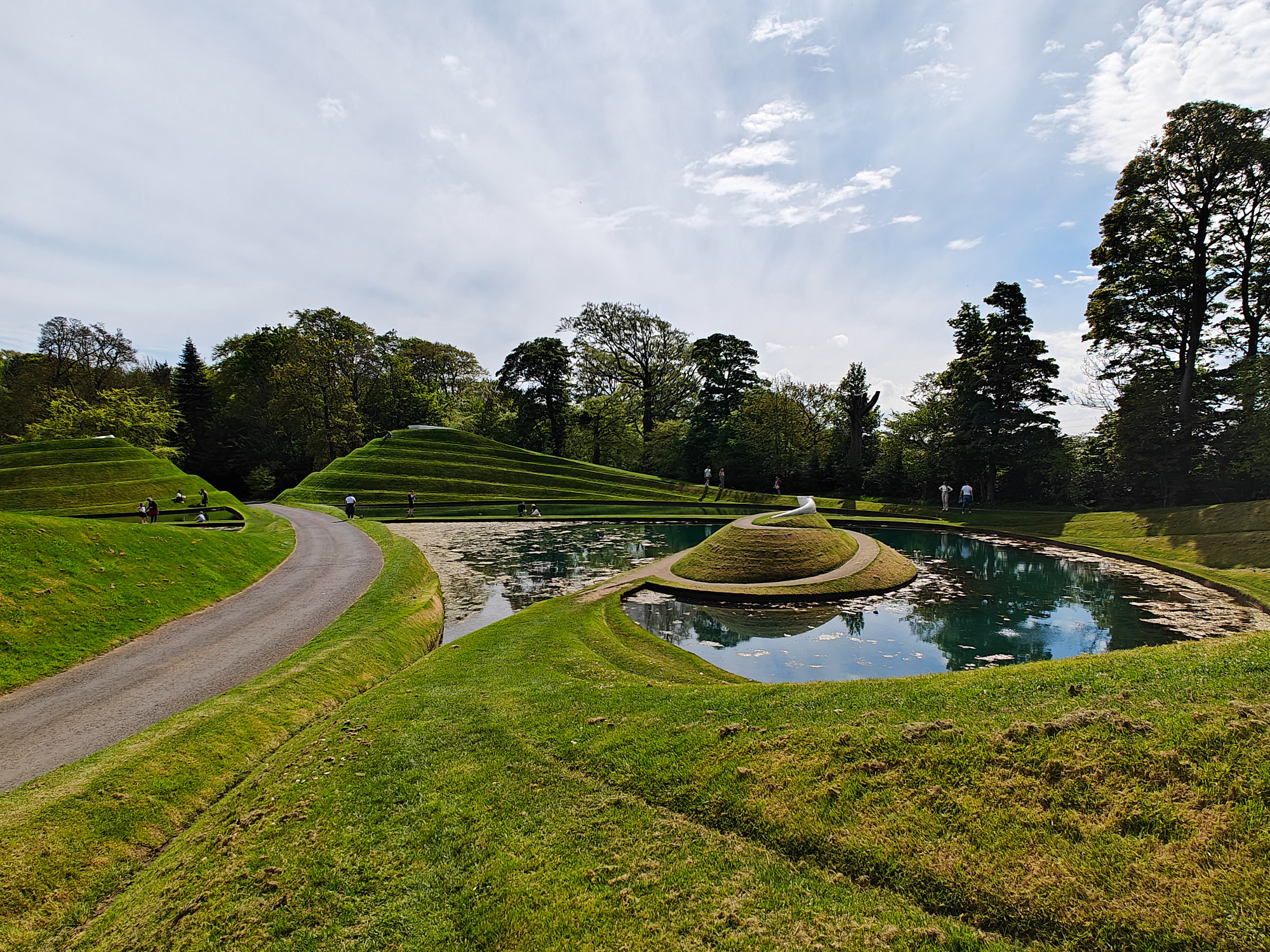






It was here that recessed.space found Lindsey Mendick’s
grotesque ceramics last year (see 00128) and now it’s the turn of this season’s
artist, painter Andrew Sim. Attached to Edinburgh’s Modern Institute gallery,
Sims is based between Scotland and New York with a playful practice that in
this instance takes aim at moments of nature in the cities the artist has
resided.
Crafted in an innocent style, the bushes, trees, and flowers are extracted from suburban settings and transplanted into a world of their own, and of Sims’ imagination. Glowing against jet-black backdrops, totemically filling their frames – and supplanted Sim’s repeat-motifs of two rainbows and a werewolf – there is also a poetic interplay between the subjects of the paintings and the floral plasterwork of the ceiling above. Outside, in the adjoining garden is a teetering stack of oversized ceramic snail shells glistening as water trickles over and into the ornamental pond below, created by artist Laura Aldridge.
Crafted in an innocent style, the bushes, trees, and flowers are extracted from suburban settings and transplanted into a world of their own, and of Sims’ imagination. Glowing against jet-black backdrops, totemically filling their frames – and supplanted Sim’s repeat-motifs of two rainbows and a werewolf – there is also a poetic interplay between the subjects of the paintings and the floral plasterwork of the ceiling above. Outside, in the adjoining garden is a teetering stack of oversized ceramic snail shells glistening as water trickles over and into the ornamental pond below, created by artist Laura Aldridge.
The joy of Jupiter Artland is the unexpected. While larger
than most domestic gardens, the fact so much art – and not small art –
is squeezed into the site doesn’t mean that a circular walk isn’t punctuated by
repeated moments of surprise, joy and creativity. Over a decade and a half,
Jupiter Artland has amassed quite the collection of site-specific artistic
projects – and there would have been even more if some had not been temporary,
marked by small plaques dotted across the place like a cultural headstone,
offering a photo and brief description of that which is no longer here.
But of the works that are here, amongst the most surprising and lead to a double take is Cornelia Parker’s gigantic rifle leaning against a tree – a reference to Thomas Gainsborough’s painting of Mr. and Mrs. Andrews, but comically distorted. Similarly out of place and oversized is Phyllida Barlow’s assortment of works in a wooded clearing. Quarry is formed of two towering concrete columns supplanted by a six-sided steel ring, as if remnants of an unknown failed civilisation’s communications network. Alongside, an enormous faux-boulder sits stranded, half appearing as a geological abnormality and half as eroded, abstracted man-carved steps.
Pablo Bronstein’s The Rose Walk emerges from the overgrowth in bright ornamentation. Few artists fuse deep architectural interest and knowledge with artist practice as much as Bronstein, though rarely does he get the opportunity to work at a legitimate architectural scale. Here, however, he has built two opposing inhabitable spaces connected by a linear path between roses. One end is a gothic portico, addressing it another modelled on historic Chinese architectural vernacular. Facing off, to walk between the two is a journey between distant geographies, and one through the 18th century stylistic tastes that is so at the core of Bronstein’s work.
But of the works that are here, amongst the most surprising and lead to a double take is Cornelia Parker’s gigantic rifle leaning against a tree – a reference to Thomas Gainsborough’s painting of Mr. and Mrs. Andrews, but comically distorted. Similarly out of place and oversized is Phyllida Barlow’s assortment of works in a wooded clearing. Quarry is formed of two towering concrete columns supplanted by a six-sided steel ring, as if remnants of an unknown failed civilisation’s communications network. Alongside, an enormous faux-boulder sits stranded, half appearing as a geological abnormality and half as eroded, abstracted man-carved steps.
Pablo Bronstein’s The Rose Walk emerges from the overgrowth in bright ornamentation. Few artists fuse deep architectural interest and knowledge with artist practice as much as Bronstein, though rarely does he get the opportunity to work at a legitimate architectural scale. Here, however, he has built two opposing inhabitable spaces connected by a linear path between roses. One end is a gothic portico, addressing it another modelled on historic Chinese architectural vernacular. Facing off, to walk between the two is a journey between distant geographies, and one through the 18th century stylistic tastes that is so at the core of Bronstein’s work.

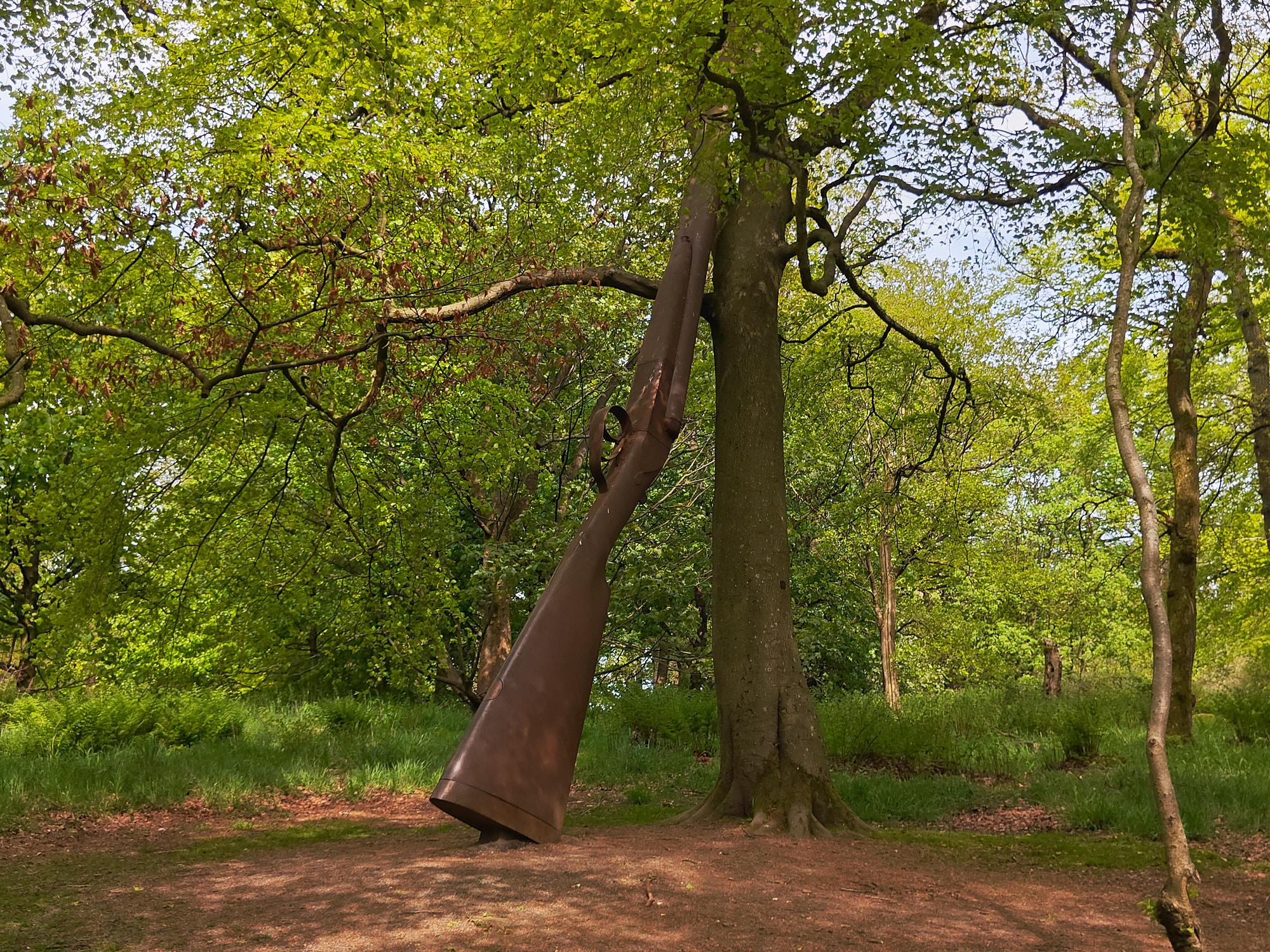
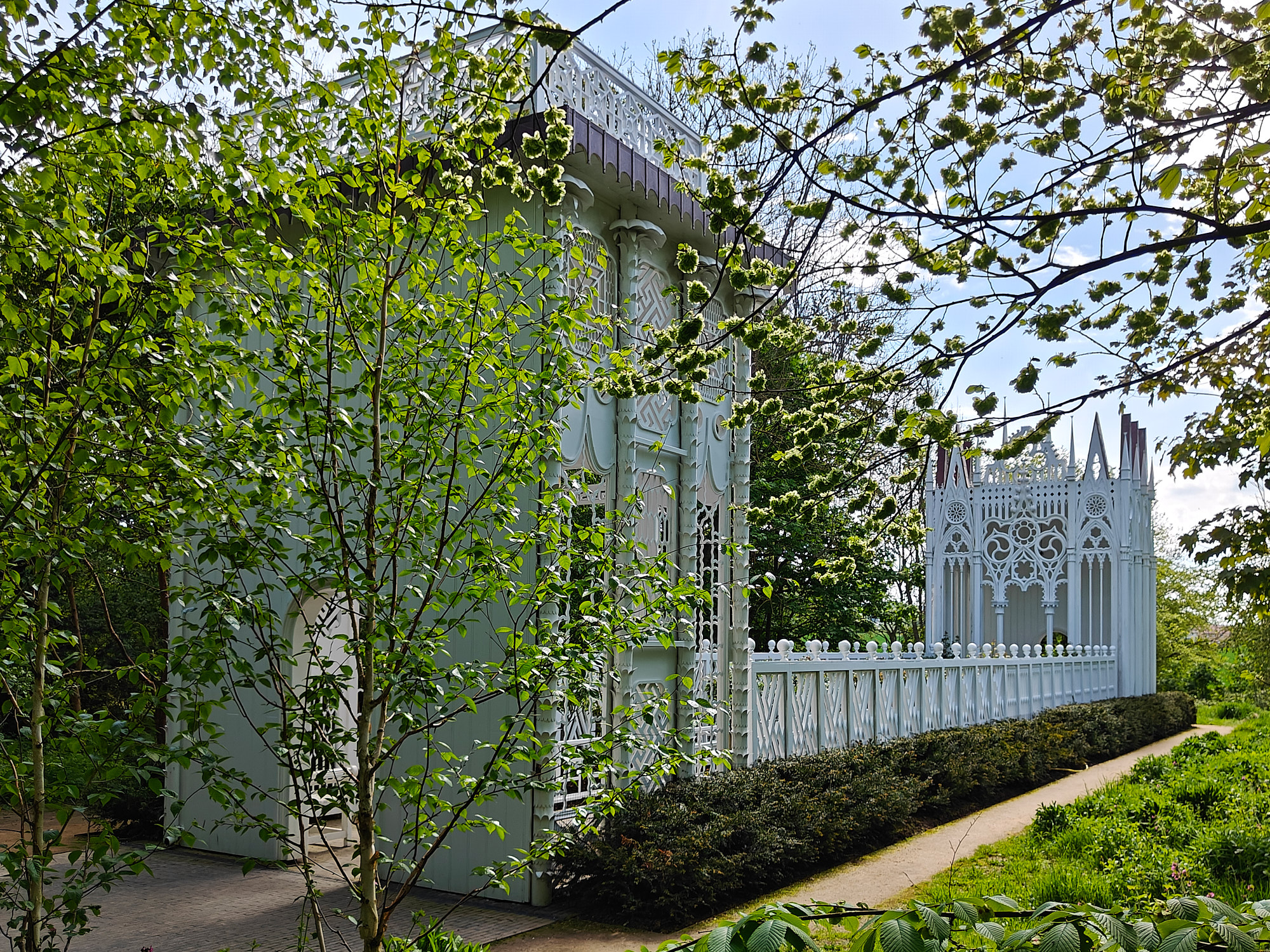
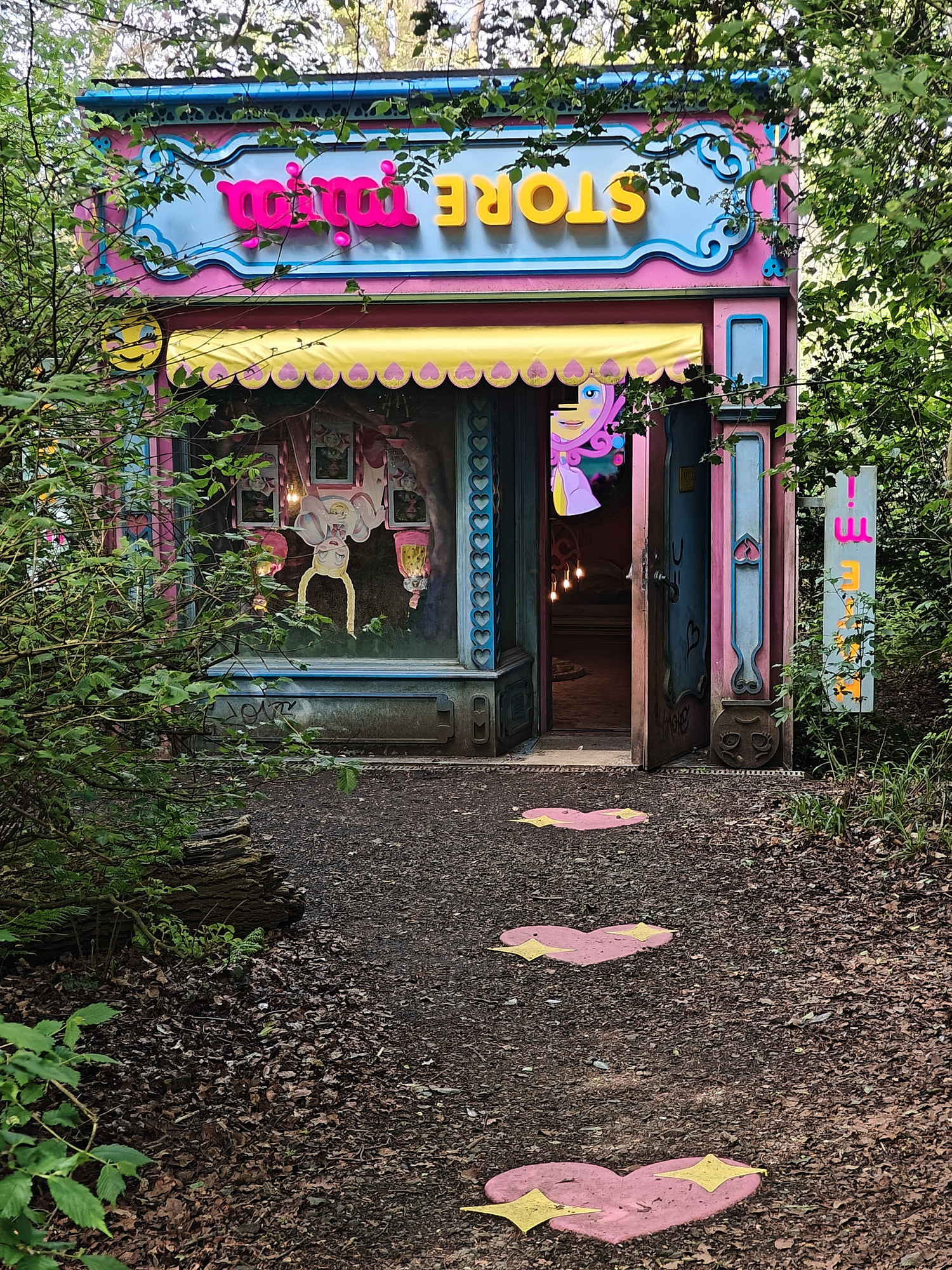

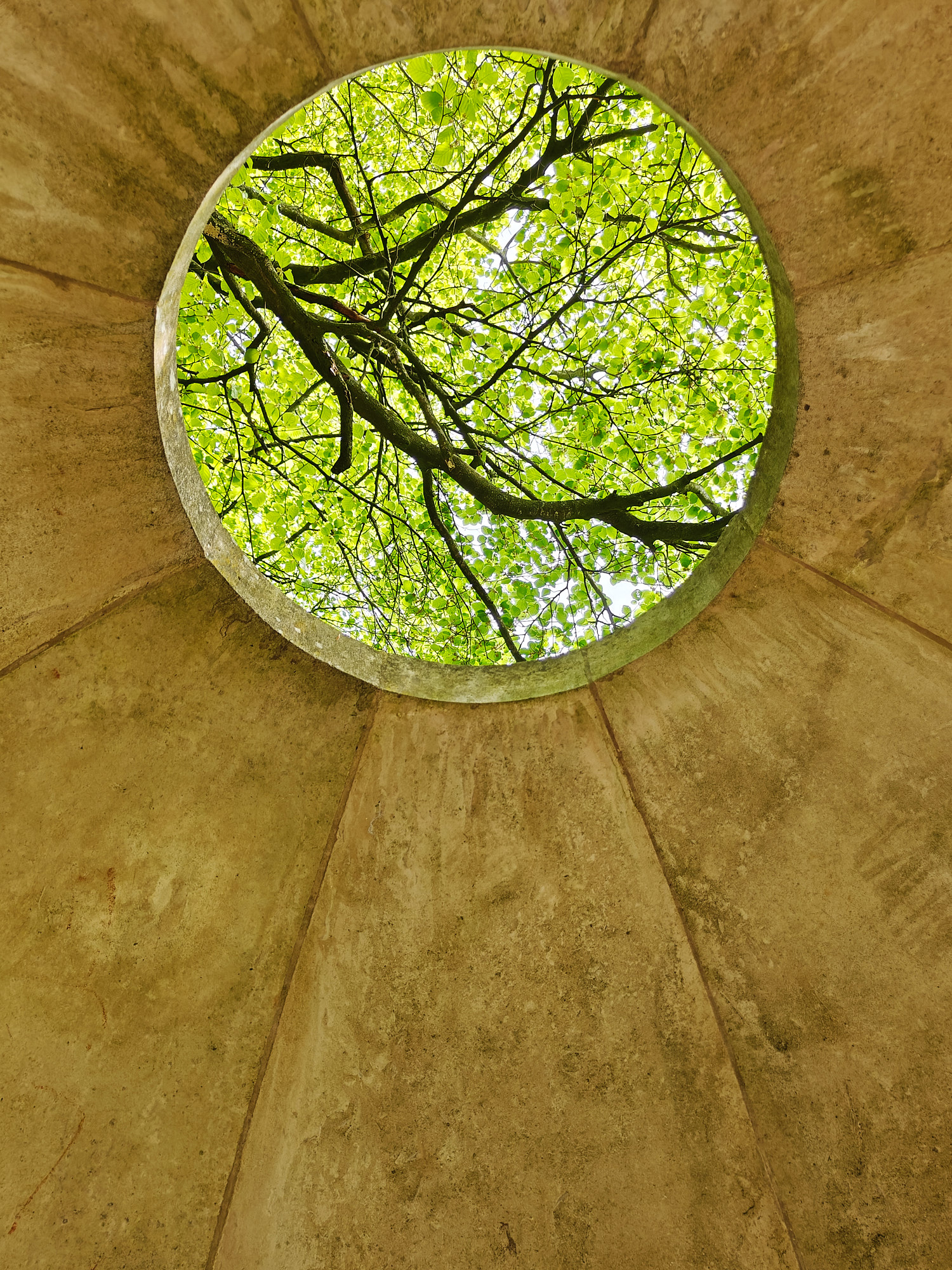
Bronstein isn’t the only artist at Jupiter Artland offering
architectural escape within the landscape. Two pieces by Ian Hamilton Finlay might
be out of place in a more formal and classical country house estate. Only
Connect is a small stone arched bridge, not quite on the Capability Brown
level of intervention, but useful to help cross a small ditch. A few steps away
is his Temple of Apollo, a compact and circular stone temple with the
capacity of only one person at a time. Looking upwards, an oculus offers a
compacted vantage of overhanging branches, while an engraving running around
the interior reads “Consecutive upon Apollo a titanic revolt in his heart… a
god definitively in exile – L. A. St-Just” – a reworking of an 1894 Walter
Pater text.
With four simple shuttered concrete walls, Nathan Coley has created a spatial separation from surrounding woods, and inside is an unexpected moment of pause, intercultural imaginaries, and break from the more playful and spectacular works around Jupiter Artland. Coley presents a fictional graveyard within which we can read the headstones of characters he has placed into the place, but also invites personal reflection upon other lives lost.
Rachel Maclean’s Upside Mimi, Down Mimi announces itself with a series of heart-shaped stepping stones in the leaf-litter and mulch of the woods. A fairytale invitation, but one which – in a true-Germanic more than Disney fairytale form – leads to a space of fear and anxiety. A pink, blue, and yellow shopfront surprisingly sits amongst the trees, but upon entering distorts the body and mind with a toyshop packed with Barbie-style dolls – but with everything, including the chandelier, upside down. This is less a site-specific work than a site-disruptive work, taking the visitor from their casual woodland stroll into an immersive space of horror.
With four simple shuttered concrete walls, Nathan Coley has created a spatial separation from surrounding woods, and inside is an unexpected moment of pause, intercultural imaginaries, and break from the more playful and spectacular works around Jupiter Artland. Coley presents a fictional graveyard within which we can read the headstones of characters he has placed into the place, but also invites personal reflection upon other lives lost.
Rachel Maclean’s Upside Mimi, Down Mimi announces itself with a series of heart-shaped stepping stones in the leaf-litter and mulch of the woods. A fairytale invitation, but one which – in a true-Germanic more than Disney fairytale form – leads to a space of fear and anxiety. A pink, blue, and yellow shopfront surprisingly sits amongst the trees, but upon entering distorts the body and mind with a toyshop packed with Barbie-style dolls – but with everything, including the chandelier, upside down. This is less a site-specific work than a site-disruptive work, taking the visitor from their casual woodland stroll into an immersive space of horror.
Other works are demonstrably more site-specific. The largest
of these, and perhaps less an artwork so much as an entire landscape in itself,
are the stepped hills and lakes that make Charles Jencks’ Cells of Life,
a seminal work from the man who was not only a landscape architect, theoretician
and writer, and creator of London’s Cosmic House. His undulating
territory is created to sit either side of Bonnington House’s entrance road as
a serene moment to set the agenda of otherness for visitors to Artland. For
those on their walk around the site who have returned to it on foot, it offers
a space of pause and separation not only from the wider landscape of artistic
encounter, but of most landscapes ever encountered – Jencks’ landscapes are
truly experientially different to any other cultivated place.
Next to the estates other – more natural-appearing – lake, sits a traditional boathouse within one of the more picturesque moments at Jupiter Artland. It is an artwork by Henry Castle, and upon entering offers up a poetic connection between here and other watery places across the country. Two rows of shelves are stacked with an assortment of glass bottles, each containing a seemingly clear liquid. The work is an archive of 100 of Britain’s rivers, from the Tamar to the Aln, the Orwell to the Gwydderig. They speak to the shared riparian connective tissue, but also to locale and precarity of environment – especially looking at this work at a time many of the selected rivers are subjected to overflow pollution from a capitalist value system.
Not far away, unassumingly standing at the edge of the estate, is what looks like a directional roadsign … but gone wrong. Pointing skywards with an arrow, Peter Liversidge’s rationally titled Signpost to Jupiterhas informs us that there are 893 to 964 million kms between the two Jupiters – planet and Artland.
Next to the estates other – more natural-appearing – lake, sits a traditional boathouse within one of the more picturesque moments at Jupiter Artland. It is an artwork by Henry Castle, and upon entering offers up a poetic connection between here and other watery places across the country. Two rows of shelves are stacked with an assortment of glass bottles, each containing a seemingly clear liquid. The work is an archive of 100 of Britain’s rivers, from the Tamar to the Aln, the Orwell to the Gwydderig. They speak to the shared riparian connective tissue, but also to locale and precarity of environment – especially looking at this work at a time many of the selected rivers are subjected to overflow pollution from a capitalist value system.
Not far away, unassumingly standing at the edge of the estate, is what looks like a directional roadsign … but gone wrong. Pointing skywards with an arrow, Peter Liversidge’s rationally titled Signpost to Jupiterhas informs us that there are 893 to 964 million kms between the two Jupiters – planet and Artland.
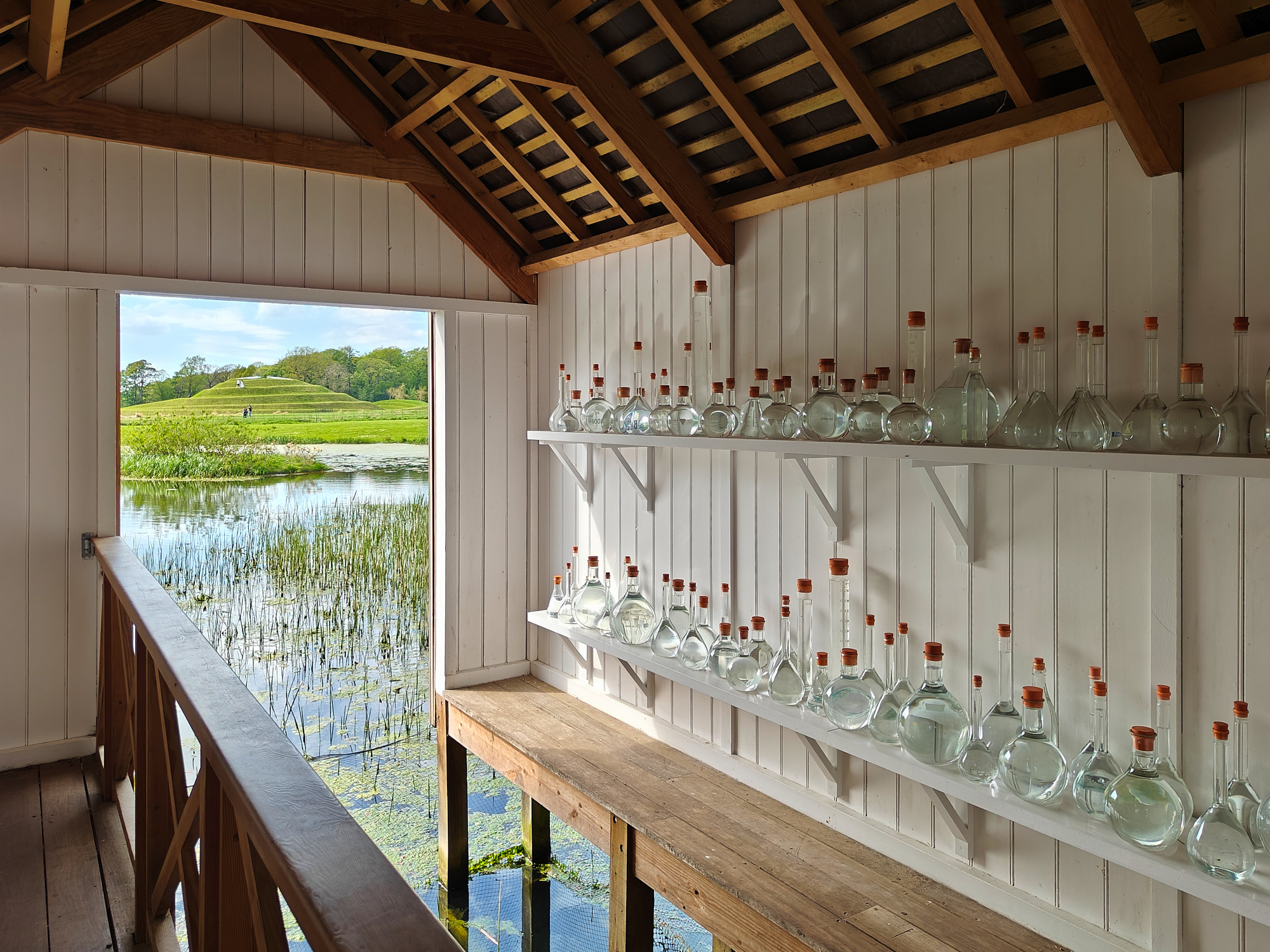
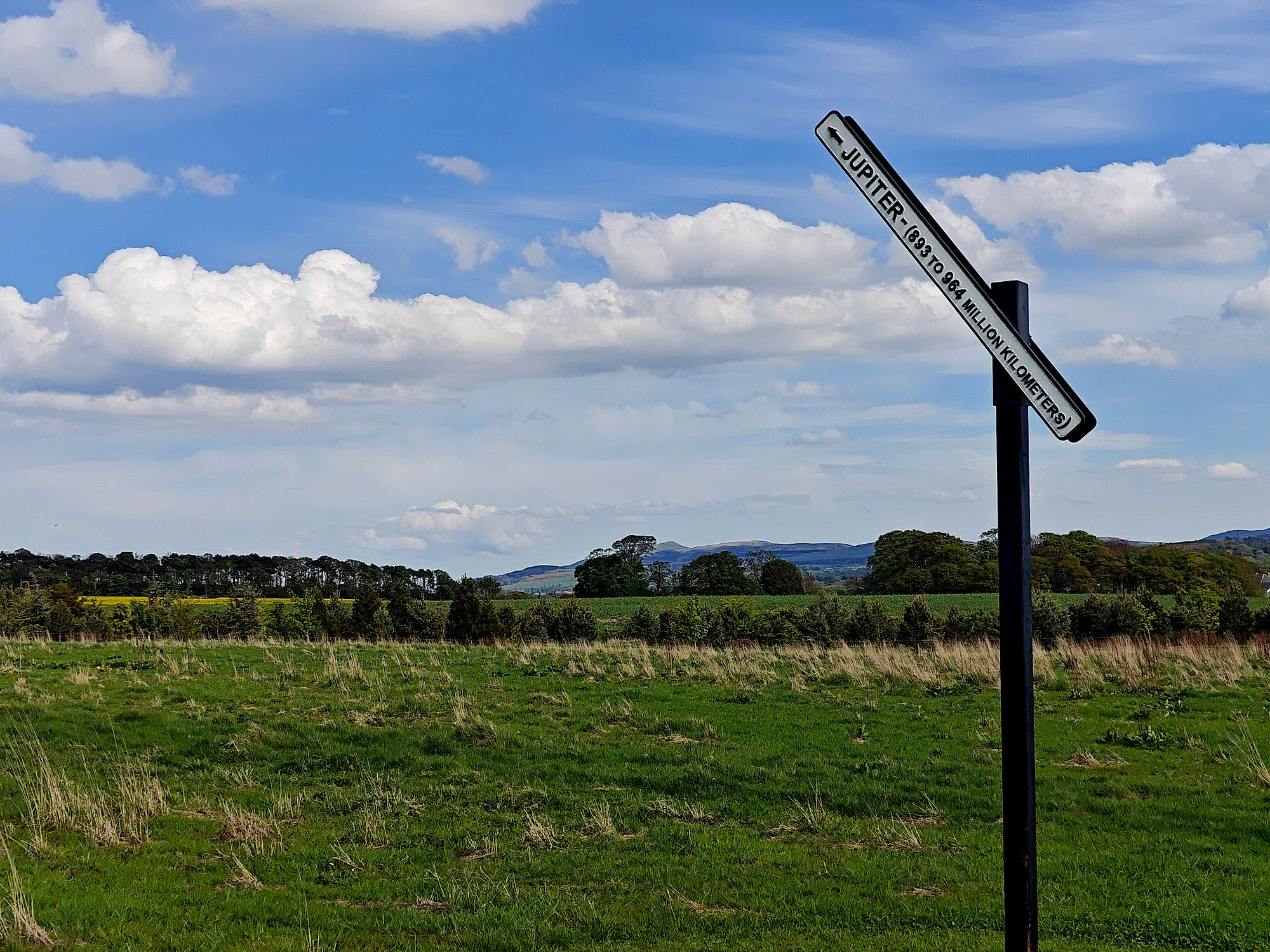



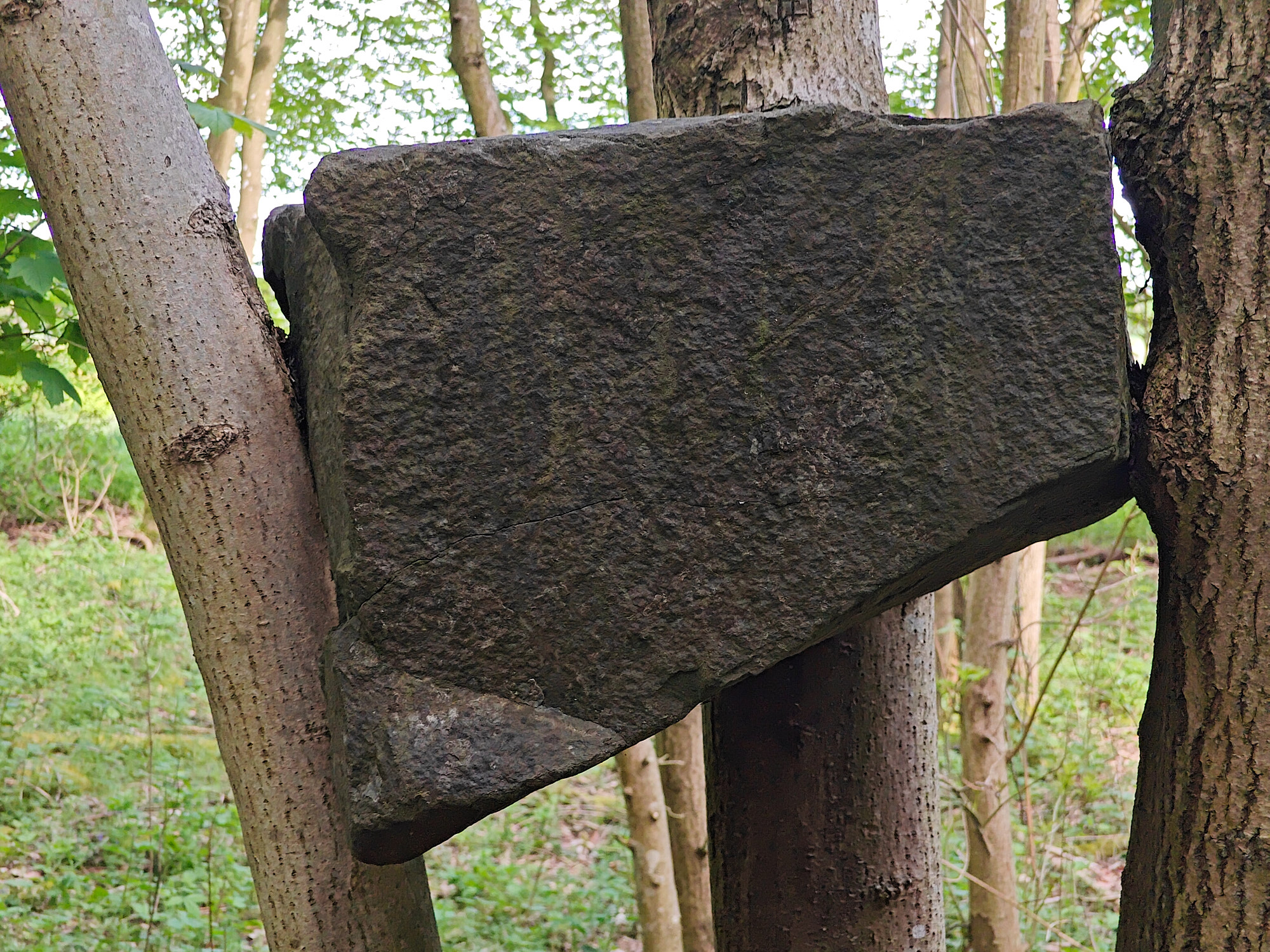
The Godfather of British land art, Andy Goldsworthy, has three
projects at Jupiter Artland, each playing with the relationship between manmade
and natural. Two are architectures with unexpected insides: with Coppice Room, the
artist repurposed a previously derelict stone building and filled it with floor
to ceiling tree trunks, creating a dark and compact woodland inside the
building; and a similar outside/inside switch happens with Stone House
(Bonnington) where a simple pitched-roof stone house can be entered to
reveal excavated bedrock in an uncanny and unsettling interior.
Stones recur in another Goldsworthy project, Stone Coppice. In 2009 the artist placed large locally-sourced rocks between the branches of coppiced trees. Over the 15 years since, some rocks have slowly lowered into a nest of branches, tightly compressed into the tree’s new growth, while others sit on the forest floor having escaped their tree and rolled to safety.
Anya Gallaccio has also played with rock, but one altogether more fantastical and bling than local granite. With The light pours out of me, Gallaccio has created a sunken folly, a shallow descent of steps through a narrow cut in the ground leading to a squared hollow lined with jagged, glowing amethyst. Referencing grottos and follies of 18th century British landscape design, this is a sensorial otherness with a sense of escape not only a couple of metres below the surface, but to an entire other place and time.
Stones recur in another Goldsworthy project, Stone Coppice. In 2009 the artist placed large locally-sourced rocks between the branches of coppiced trees. Over the 15 years since, some rocks have slowly lowered into a nest of branches, tightly compressed into the tree’s new growth, while others sit on the forest floor having escaped their tree and rolled to safety.
Anya Gallaccio has also played with rock, but one altogether more fantastical and bling than local granite. With The light pours out of me, Gallaccio has created a sunken folly, a shallow descent of steps through a narrow cut in the ground leading to a squared hollow lined with jagged, glowing amethyst. Referencing grottos and follies of 18th century British landscape design, this is a sensorial otherness with a sense of escape not only a couple of metres below the surface, but to an entire other place and time.
Ending a circular root of Jupiter Artland leads back towards
Bonnington House, passing one of Nathan Coley’s illuminated text signs proclaiming
“YOU IMAGINE WHAT YOU DESIRE” – a fragment of a George Bernard Shaw quotation.
Off to one side of the house is a swimming pool which is also an artwork. Gateway is a landscaped garden surrounding a functioning circular pool, covered in a
spill-like arrangement of 11,366 Portuguese tiles by Joana Vasconcelos.
Nearby is a cluster of visitor buildings, including a playfully designed café, shop, and Jupiter Artland’s gallery space, this season occupied by Lawnmower, an exhibition from snail shell stacker Laura Aldridge. The ceramic weirdness continues in an exhibition of slightly sinister and unnerving wall lights. Surrounded by ruffled fabric and ceramic lumps, the abstract sculptural lights took inspiration from a doll discovered while digging through a local museum’s archive.
With a video work bringing colour and noise to the space, the artist has also created a suite of kissing seats covered in ceramic and glass objects, inviting visitors to sit, fondle the works, and engage in unexpected communication.
Nearby is a cluster of visitor buildings, including a playfully designed café, shop, and Jupiter Artland’s gallery space, this season occupied by Lawnmower, an exhibition from snail shell stacker Laura Aldridge. The ceramic weirdness continues in an exhibition of slightly sinister and unnerving wall lights. Surrounded by ruffled fabric and ceramic lumps, the abstract sculptural lights took inspiration from a doll discovered while digging through a local museum’s archive.
With a video work bringing colour and noise to the space, the artist has also created a suite of kissing seats covered in ceramic and glass objects, inviting visitors to sit, fondle the works, and engage in unexpected communication.
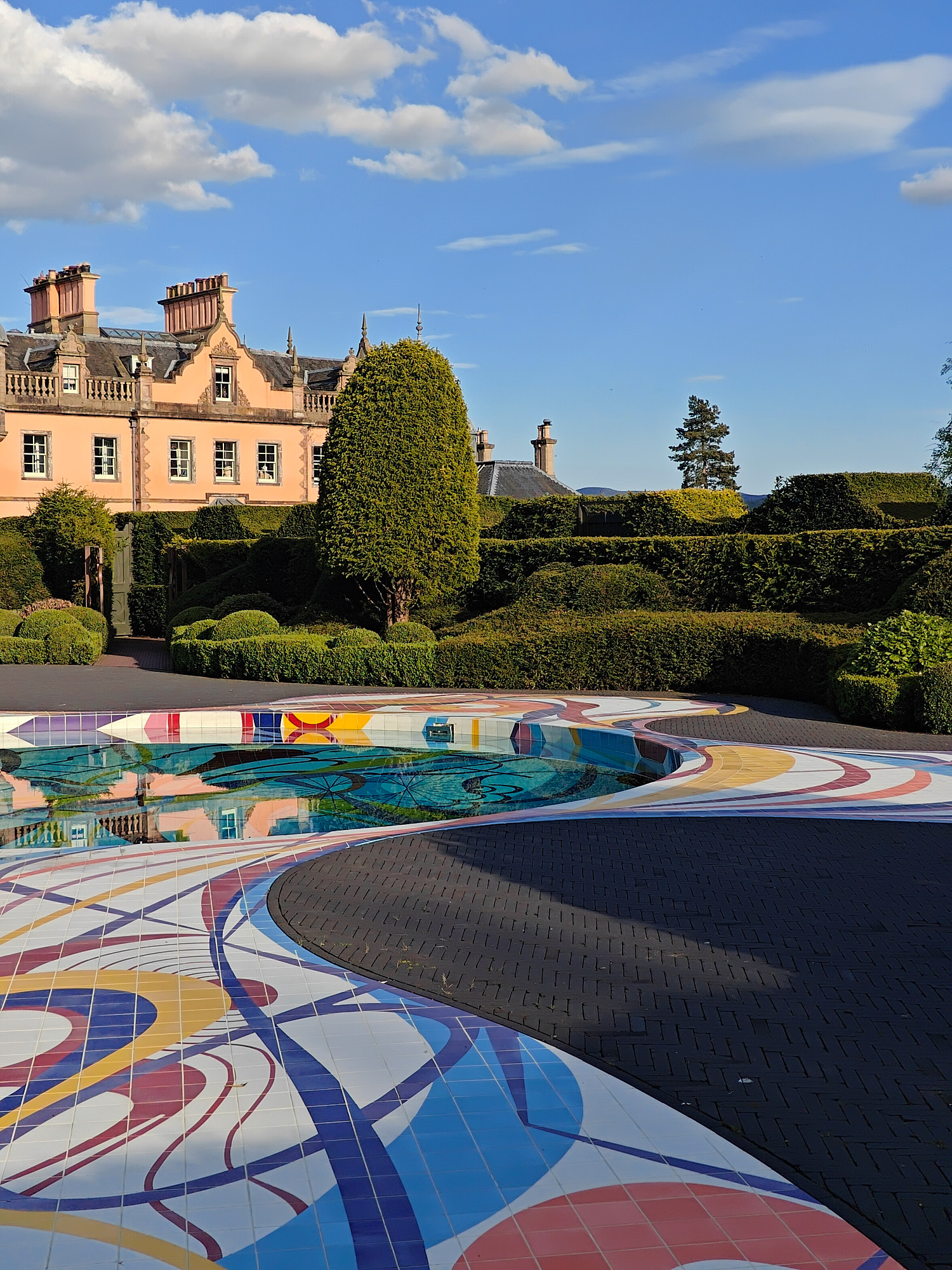


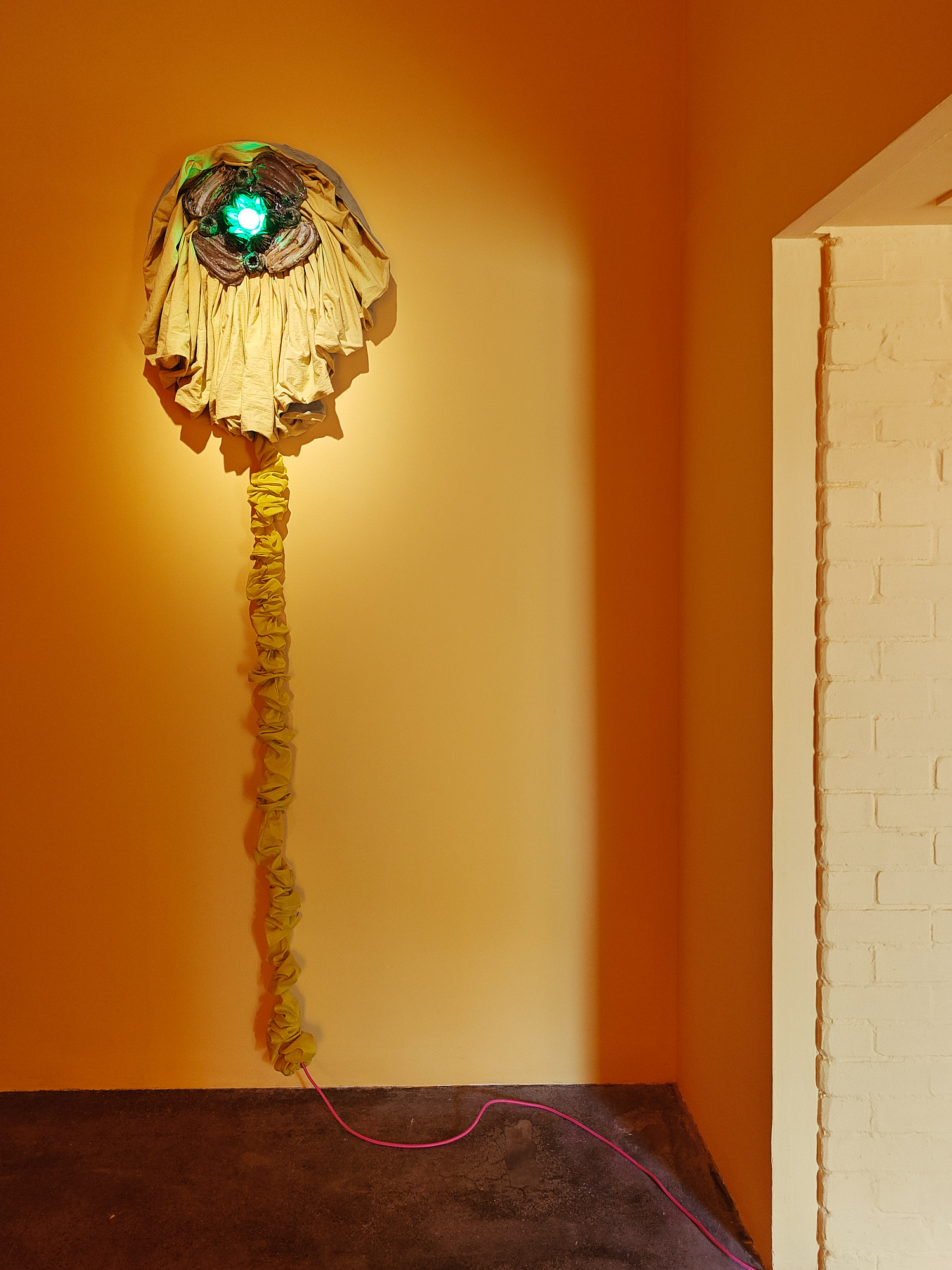
There are countless more weird, fantastical, and
site-playing works across Jupiter Artland, including pieces from the likes of Christian
Boltanski, Tracey Emin, and Laura Ford. There will also be new additions over
coming years within a landscape designed to intrigue and inspire visitors and
creative practitioners alike.
Open until the end of September before closing up for the winter months, a busy calendar of events runs through the summer, and the annual Jupiter Rising party night is on the 17 August, to coincide with Edinburgh Art Festival (see 2023’s festival at 00124).
While the urban landscape, rugged geology, and architectural overload of Edinburgh is spectacular, if in the city it may be worth taking the short trip just outside to Jupiter Artland for an altogether more unusual and playful coming together of place, art, and architecture.
Open until the end of September before closing up for the winter months, a busy calendar of events runs through the summer, and the annual Jupiter Rising party night is on the 17 August, to coincide with Edinburgh Art Festival (see 2023’s festival at 00124).
While the urban landscape, rugged geology, and architectural overload of Edinburgh is spectacular, if in the city it may be worth taking the short trip just outside to Jupiter Artland for an altogether more unusual and playful coming together of place, art, and architecture.
Jupiter Artland is an
award-winning, contemporary sculpture park, located just outside Edinburgh. Set
over 100 acres of
meadow, woodland and five
indoor gallery spaces, Jupiter Artland has to date commissioned over 35
permanent site-specific sculptures from the world’s
leading artists including Alec Finlay, Andy Goldsworthy, Anish Kapoor, Antony
Gormley, Anya
Gallaccio, Charles Jencks,
Christian Boltanski, Cornelia Parker, Helen Chadwick, Henry Castle, Ian
Hamilton Finlay, Joana
Vasconcelos, Laura Ford,
Marc Quinn, Nathan Coley, Nicolas Party, Pablo Bronstein, Peter Liversidge,
Lindsey Mendick, Phyllida Barlow, Rachel
Maclean, Sara Barker, Shane Waltener, Tania Kovats, and Tracey Emin. A curated
annual
programme of exhibitions and
events from leading visionary artists and emerging talents, as well as public
talks, assemblies, and an active live
art programme, make Jupiter Artland a thriving location for new ideas.
www.jupiterartland.org
Andrew Sim lives and works
between New York and London. Selected exhibitions include: Four rainbows, three
werewolves,
four trees, four santas
& five horses (one with wings), Beyond The Modern Institute, 1-4 Walker’s
Court, London, (2023); six werewolves without hair (two
gold, from the future), two santas, two daisies, a sunflower and a monkey
puzzle tree), WINDOW,
Anton Kern, (2023); a
sunflower, six trees, three birds and two horses (one with wings), The Modern
Institute, Osborne Street
(2023), To be a giant and
keep quiet about it, Margot Samel, New York (2022); Four Horses and a Sunflower
(Actual Size), The Modern Institute, Aird’s
Lane (2022); Heal the sick, raise the dead, Part of Glasgow International
(2021); We Two Bigfoots
Together Clinging,
Prouddick, London (2020).
www.themoderninstitute.com/artists/andrew-sim
Laura Aldridge lives in
Glasgow and works in Paisley. Recent solo exhibitions include sumVIGOUR, Cample
Line, Cample
(2021); The Outside is
Inside Everything We Make – Laura Aldridge, Leanne Ross, Judith Scott, Kendall
Koppe, Glasgow (2021); fromKStoyou,
Kunsthalle Stavanger, Norway (2020–2021); Indirect Sunlight – Laura Aldridge
and James Rigler, New
Gallery, London, (2018);
Plant Scenery of the World, Inverleith House, Edinburgh (2017); Go Woman Go!,
British Council in
Nigeria Season, Abuja,
Nigeria (2016); Inside All My Activities, Koppe Astner, Glasgow (2016); One to
another, one-to-one, Passerelle, Centre d‘art
contemporain, Brest (2015); California wow!, Tramway, Glasgow (2015) and Laura
Aldridge, Studio
Voltaire, London (2011).
Aldridge is a founding member of Sculpture House, Paisley, run by a group of
artists with a passion for sculpture and social
inclusion, they bring together professional artists and members of the
community, widening access to
the visual arts.
www.lauraaldridge.co.uk
Will Jennings is a London based writer, visual artist, and educator interested in cities, architecture, and culture. He has written for the RIBA Journal, the Journal of Civic Architecture, Quietus, The Wire, the Guardian, and Icon. He teaches history and theory at UCL Bartlett and Greenwich University, and is director of UK cultural charity Hypha Studios.
www.willjennings.info
www.themoderninstitute.com/artists/andrew-sim


